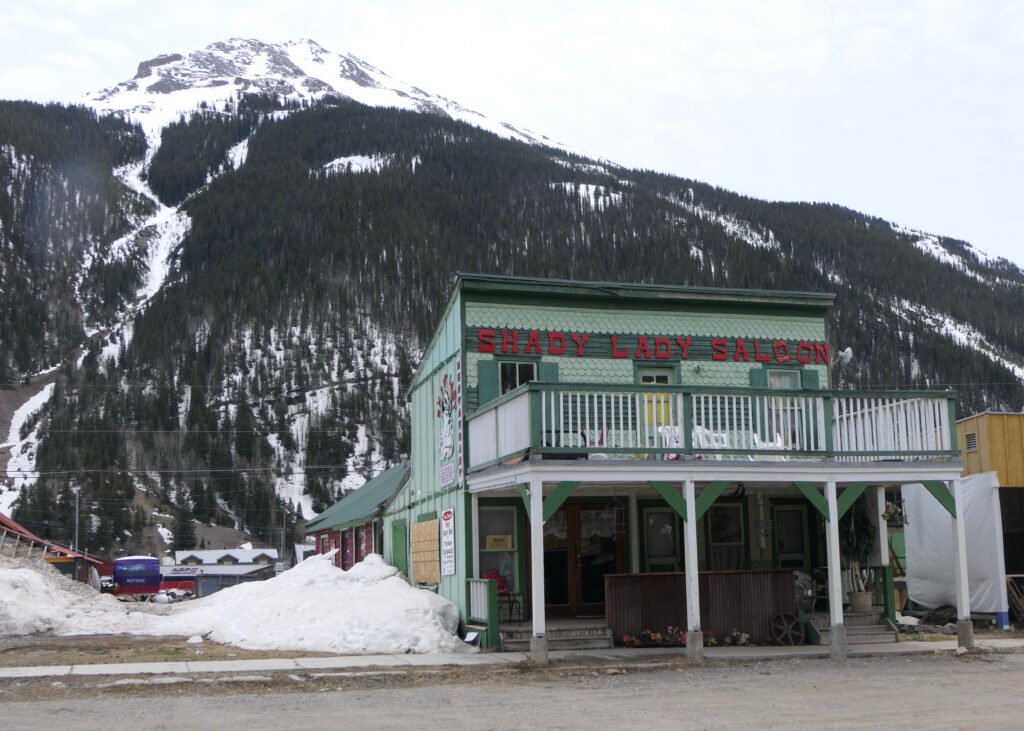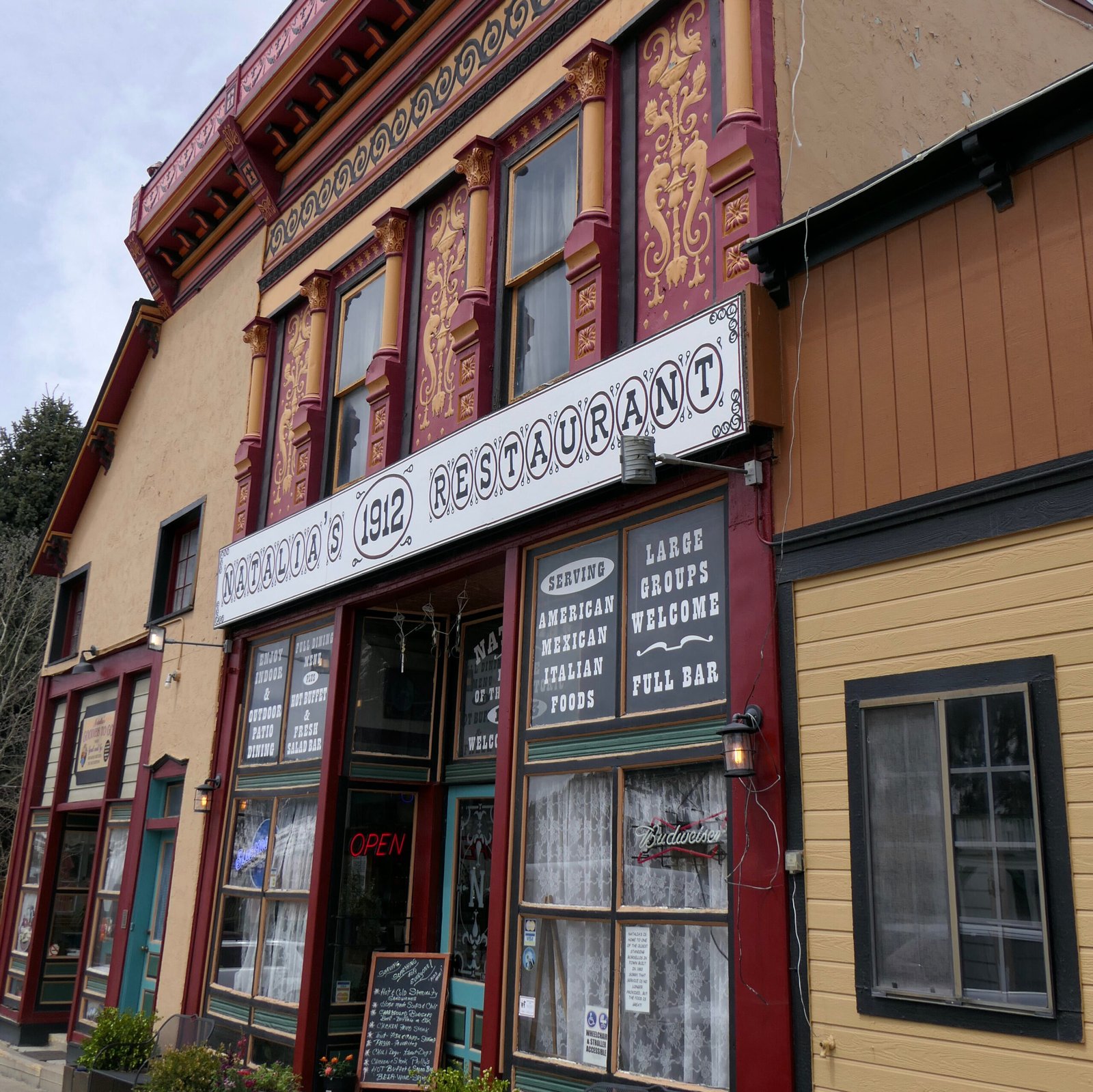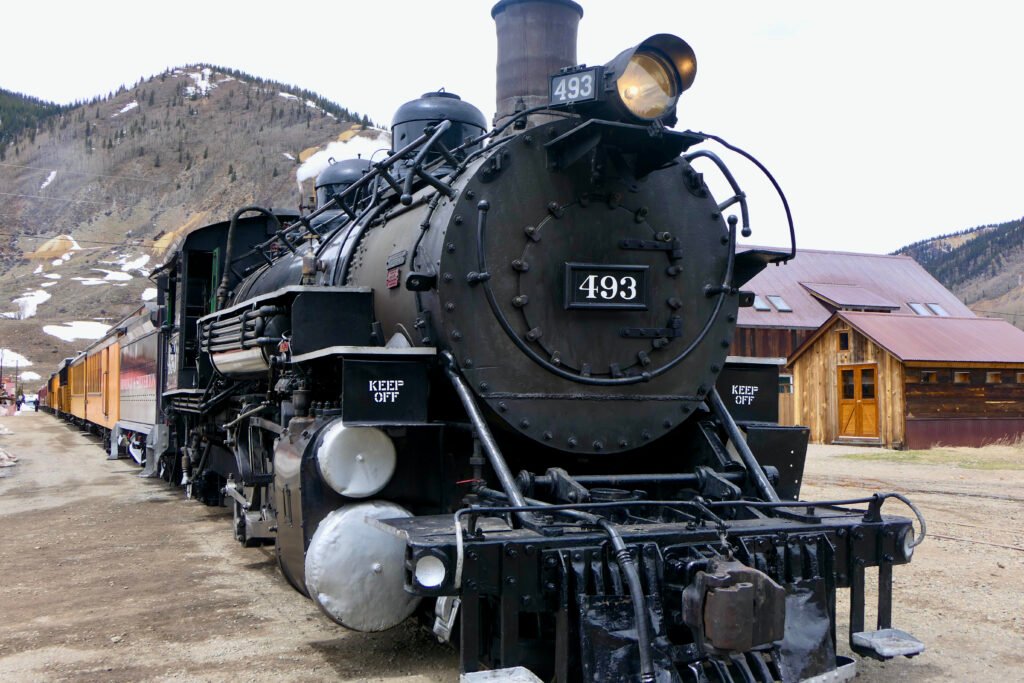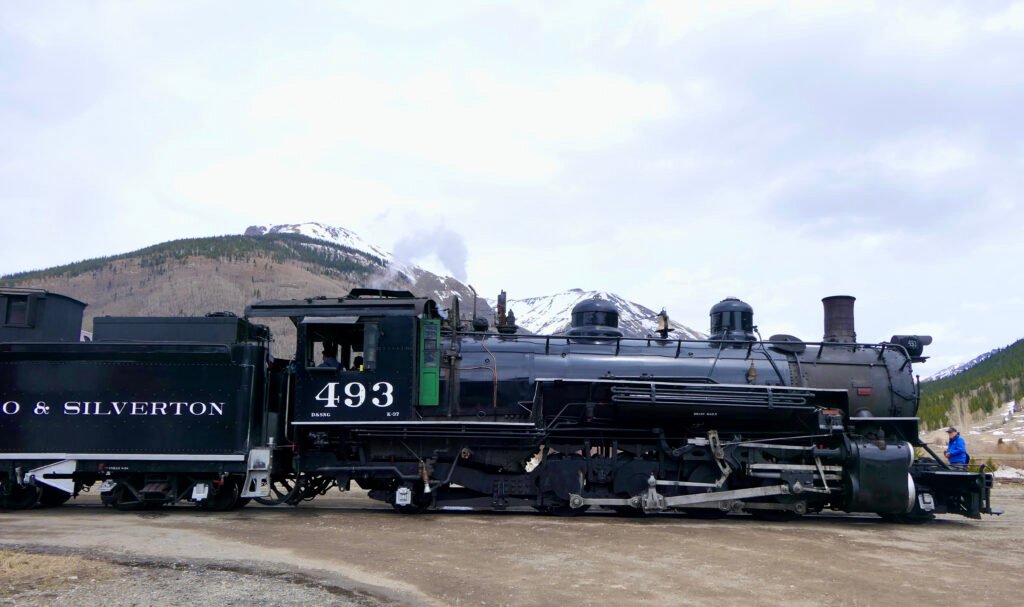Ouray to Durango – 135 miles

It’s early morning and we’re preparing to head south, up into the mountains to tackle the Million Dollar Highway. Classed as one of America’s most spectacular roads, there are a few theories as to where the name for the highway came from. It could be that the spectacular views looked a million dollars, or the fact that locals used to joke that they would only attempt it if paid a million dollars to do so. The steep grades, winding turns, snow and ice for half the year, and a distinct lack of guard rails makes this mountain pass a challenging drive. Almost no guard rails seems madness, but with up to 300 inches of snow falling annually, it allows the ploughs to push the snow off the side of the road, and anyway there are many places where there is literally no room to place barriers. It also means drivers take more care and negotiate the hairpins as if their life depended on it – which it does.
Though the entire stretch from Ouray to Silverton is called the Million Dollar Highway, it is actually just the twelve miles south of Ouray through the Uncompahgre Gorge, which is an incomprehensible name to pronounce anyway, to the summit of Red Mountain Pass. The name more likely came from the fact that each mile on the Million Dollar Highway cost around a million dollars to build.

The snow starts to fall just as we are leaving Ouray. I am somewhat apprehensive about starting the journey. If it’s falling heavily here, what is it like at 11,000 feet, coupled with the difficulty of the drive even in good weather. Like all good adventurers we ignore the warnings and carry on. As usual Americans tend to overdo the hype. Yes – the snow is thick, the drive spectacular, the guard rails absent and the climb awesome, but it was no more difficult than driving a one-track road in the north of Scotland. Just a lot fewer highland cows to avoid.

Just past the summit we watch two skiers sliding to a halt after a steep run down one of the many slopes. With no ski lift, it must have been a helluva climb to get up the mountain to the point where it made sense coming here to ski in the first place! I admire their tenacity, if not their reasoning.

We’re still at 9,800 ft when an old abandoned mine comes into view as we run into Ironton, described by Wikipedia as an “extinct” town. I would never describe a settlement where buildings still stand erect and proud, if somewhat dilapidated, as extinct. Communities like this which were once thriving, communicate a vision of what has gone before, like memories of a distant relative who has passed on. This little enclave may have passed, but somehow the soul remains in the wooden timbers still surviving the elements, but as each winter passes more abandoned shacks topple in the winter gales.
This is part of the Red Mountain Mining district where up to 40 mines operated at its peak. There is a good deal of snow today, and apparently not an easy track to encourage us to investigate, so we leave it for another trip, and carry on down the mountainside into the larger and non-extinct popular old mining town of Silverton.

I love the place immediately. It’s uncompromising, with a seemingly haphazard way the town was laid out, but with a classic wild west style Main St, long and wide enough for a Jumbo jet to land with room to spare. We walk around the few streets taking in the almost film set like buildings. With exotic names such as Bent Elbow, presumably a saloon, Shady Lady Saloon most definitely a bar, and Natalia’s Restaurant which advertises itself in the window as the former brothel in days gone by, pointing out that this service is no longer available, but the food is good. Shame really.


July 1882 the Denver & Rio Grande Railroad rolled into Silverton from Durango. Apparently, the growth was dramatic as by the following year, Silverton boasted of having a population of 2,000 people with 400 buildings, including 2 banks, 5 laundries, 29 saloons, several hotels and a red-light district situated on Blair Street which would ultimately assume great notoriety.

Eight years earlier, men were bringing their wives and families to live in Silverton. This influx of families provided an incentive for citizens to keep at least part of the town respectable. An imaginary line apparently ran down Greene Street dividing the town between the law-abiding, church-going residents and the gamblers, bordello’s, variety theatres, dance halls and saloons. Gambling and prostitution were generally accepted so long as the practice didn’t upset the more respectable areas of town and indeed the fines imposed for scandalous or drunken behaviour were put to good use to improve Silverton facilities. Bordellos flourished. Saloons stayed open round the clock. Silverton was wild, wicked and sinful. Then came the crash of 1893 and the exodus began. Saloon keepers closed their doors. Dance halls were boarded up, and the bordello’s went quiet.
Today for miles around, the ghostly remains of the bonanza days are visible, boarded-up mines and windowless cabins recalling a time when Silverton roared. Now the town has nothing but tourism to keep it afloat.
We head into a shop entitled Railroad Art where we meet the owner Scotty, another fascinating character who tells me his wife has only just come back from her home country of Thailand. Apparently, she doesn’t do winters in Silverton which at -15 degrees centigrade on an average day, I’m with her on that. Scotty (can’t get away from the home connection can I?) apparently stays behind in winter to mind the store. He regales me with tales of the railways in the UK. He knows them all and I appreciate his knowledge but by the time we get down to talking about the size of track gauges, it’s time to depart. I buy a poster out of desire to make Scotty’s day, letting us know the steam train is due in town in a few minutes.

We rush down to the yellow clapboard station just at the edge of town as a high-pitched whistle in the distance heralds the arrival of the Durango and Silverton steam train, lumbering through the valley into town. As we stand expectantly beside the track, the train puffs into the station, then through it and keeps on going with steam hissing like a dragon. It disappears up a side street where the track finishes right in the middle of town. Clearly, we had miscalculated the need for those onboard to be dropped right outside the best café in Silverton. Their legs clearly couldn’t sustain the 200 yard walk from the station proper. What would all those long disappeared hardy miners have thought?

Rain hangs in the air above the old Victorian buildings, as the train idles on the track like some great black panther waiting to pounce. The visitors have two hours to explore the town, which is probably an hour too long, unless you are going to take in a leisurely lunch. There isn’t a lot to see here, but it’s as authentic an old mining town as you can get, in a time where tourists provide the only income.
The black smoke pours from the locomotive as it fires up and gets ready to leave. Passengers boarded, it trundles out of town, its whistle sounding a mournful farewell.

As the train disappears on its 3.5 hr journey back to Durango, rain soaks the San Juan Mountains in the background, weeping at the visitors departure. That is, until tomorrow, when the next haul of day trippers arrive and the retail shops in town can smile again. Silverton’s boom days ended years ago. Without the train and its summer tourists, only a Rocky Mountain ghost town would remain.
Highway 550 south, or San Juan skyway to Durango is peppered with scenic overlooks, as each view tries to compete with the next in some high altitude “best panorama of the year” contest. Admittedly the actual high point of the drive isn’t so much the 11,000 ft Molas Pass, more the stunning stretch of highway where the views of rolling country meadows backed by jagged peaks, split your attention between road and mountain range.
In Catholic doctrine, souls atone for past sins in purgatory before entering heaven. For centuries, purgatory was often regarded as an actual physical place. Well today we find it. The town of Purgatory is hiding in the San Juan Mountains 25 miles north of Durango. The name originated from some witty farmer who lived in the area way back. He adopted the name for a nearby creek, a tributary of the Rio de las Animas Perdidas (the River of Lost Souls), dubbed by Spanish explorers for a group who disappeared on the river during Durango’s early history. I wonder if they were all Catholics?……..Now it’s a ski resort of some renown, where no doubt lost souls are a fairly regular occurrence on the slopes or in the bars.

We roll into Durango as the late afternoon sun is slowly placing a golden silk sheet over the surrounding hills. Our AirBnB accommodation is down a short dirt track, which for some unknown reason always suggests to me that at the end of the road some mysterious cabin in the woods might appear, straight out of a horror film. Indeed, a large wooden house now sits in front of us, with a barn style front door, the top half open just asking you to lean over and peep in to view the terror beyond. However, it’s a bit difficult to re-create a scene from some spooky movie when the place is called “Country Sunshine Bed + Breakfast”…………We like the place immediately, and our hosts Walter and Jodie are generous, kind and helpful. The dog seems to like us too, and we thank me for booking two nights here as we feel very comfortable.


